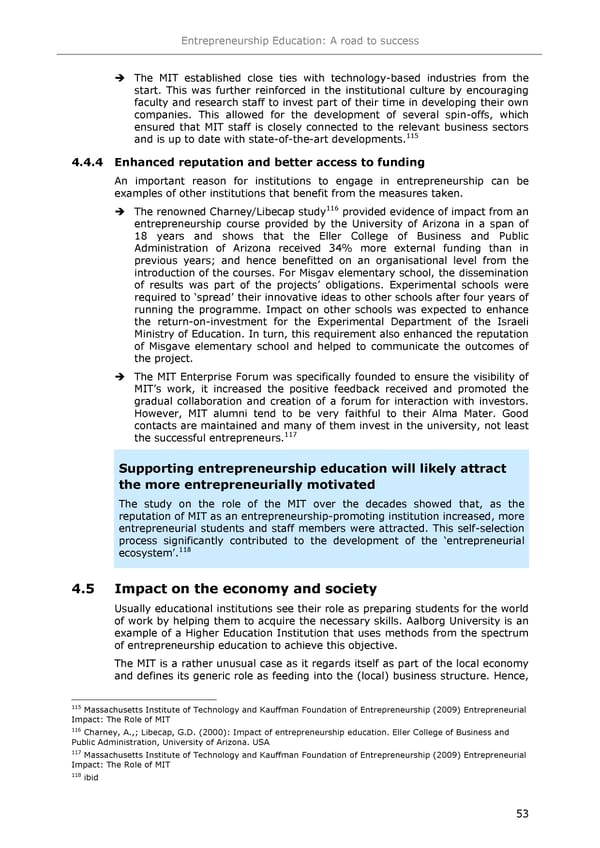Entrepreneurship Education: A road to success The MIT established close ties with technology-based industries from the start. This was further reinforced in the institutional culture by encouraging faculty and research staff to invest part of their time in developing their own companies. This allowed for the development of several spin-offs, which ensured that MIT staff is closely connected to the relevant business sectors 115 and is up to date with state-of-the-art developments. 4.4.4 Enhanced reputation and better access to funding An important reason for institutions to engage in entrepreneurship can be examples of other institutions that benefit from the measures taken. 116 The renowned Charney/Libecap study provided evidence of impact from an entrepreneurship course provided by the University of Arizona in a span of 18 years and shows that the Eller College of Business and Public Administration of Arizona received 34% more external funding than in previous years; and hence benefitted on an organisational level from the introduction of the courses. For Misgav elementary school, the dissemination of results was part of the projects9 obligations. Experimental schools were required to 8spread9 their innovative ideas to other schools after four years of running the programme. Impact on other schools was expected to enhance the return-on-investment for the Experimental Department of the Israeli Ministry of Education. In turn, this requirement also enhanced the reputation of Misgave elementary school and helped to communicate the outcomes of the project. The MIT Enterprise Forum was specifically founded to ensure the visibility of MIT9s work, it increased the positive feedback received and promoted the gradual collaboration and creation of a forum for interaction with investors. However, MIT alumni tend to be very faithful to their Alma Mater. Good contacts are maintained and many of them invest in the university, not least 117 the successful entrepreneurs. Supporting entrepreneurship education will likely attract the more entrepreneurially motivated The study on the role of the MIT over the decades showed that, as the reputation of MIT as an entrepreneurship-promoting institution increased, more entrepreneurial students and staff members were attracted. This self-selection process significantly contributed to the development of the 8entrepreneurial 118 ecosystem9. 4.5 Impact on the economy and society Usually educational institutions see their role as preparing students for the world of work by helping them to acquire the necessary skills. Aalborg University is an example of a Higher Education Institution that uses methods from the spectrum of entrepreneurship education to achieve this objective. The MIT is a rather unusual case as it regards itself as part of the local economy and defines its generic role as feeding into the (local) business structure. Hence, 115 Massachusetts Institute of Technology and Kauffman Foundation of Entrepreneurship (2009) Entrepreneurial Impact: The Role of MIT 116 Charney, A.,; Libecap, G.D. (2000): Impact of entrepreneurship education. Eller College of Business and Public Administration, University of Arizona. USA 117 Massachusetts Institute of Technology and Kauffman Foundation of Entrepreneurship (2009) Entrepreneurial Impact: The Role of MIT 118 ibid 53
 Entrepreneurship Education Page 56 Page 58
Entrepreneurship Education Page 56 Page 58